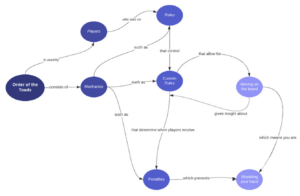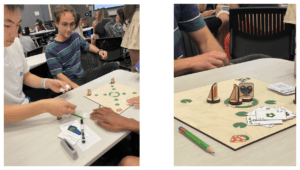Team 25 P1: The Order of the Toads
Artist’s Statement
Our game, Order of the Toads, promises expression, fellowship, and challenge as players create rules to sabotage each other while trying to be the first to discard their hand. To accomplish this, players are penalized when they fail to follow a rule, kept in check by the Great Toad (the moderator). Each penalty incurs an additional card to the offender’s hand and as a card discarding game, penalties are a sufficient negative consequence. They also encourage players to express themselves and impose a challenge to others by inventing ridiculous rules to follow so that others get penalized more often. To further reward players who don’t get penalized and to level the playing field, we have the Lilypad Pond (board). Every successful turn allows a player to move one hop on the Lilypad Pond, unlocking abilities like asking the Great Toad a question about the rules and even learning another player’s rule if they advance to their lilypad. With a simple and cute froggy theme, we hope to encourage players to get silly and creative, making the game a fun, bonding experience for everyone involved.
A Concept Map of Order of the Toads’ Mechanics
Initial Decisions
Our initial design plan was to create an offshoot of the game Mao, but instead of one player having all the power, every player is able to create their own rule. This decision naturally caused many mechanics to start to take shape. For example, if everyone makes up a rule, who is the source of truth? To answer this, we created the role of a moderator whose job is to keep track of all the players’ rules, and through several iterations of playtesting, we fine-tuned the role to make it not such a huge advantage.
Next, we faced the question: how do we level the playing field so that players don’t feel demoralized if they can’t figure out a rule? Enter the idea for a board element. We wanted to somehow have a situation where players are able to glean information from each other and increase the social aspect of the game. With that, we added a condition where, once players reach the center of the board, they can ask the moderator a yes or no question to help them figure out some rules. We also decided that the board be shaped in a wheel-and-spoke fashion, with each spoke representing the path to a specific player’s “secret tower” that each player starts the game at. If another person reaches a player’s tower, the player is required to reveal their secret rule to the visiting player. An important distinction between the moderator and individual player towers is that the interaction at a player’s tower is player-to-player, whereas everyone hears what question is asked of the moderator and the answer. We framed it this way because we wanted to incite the dynamic of strategic thinking when asking questions so not too much is revealed.
Just from this one decision to add the board element, several more things had to be considered: should the moderator have a player piece? How many spaces should players need to move before getting to the center? Does the addition of the board restrict the number of players who can play? If so, what should the maximum number of players be? All of these questions eventually got answered through continuous iterations after a few playtests, but for our first prototype, we restricted the number of players to 9 so that the circle board could have 8 spokes with 4 steps each, and the moderator did not have a tower since they already knew all the rules. However, as expected, these specific numbers quickly changed with each playtest.
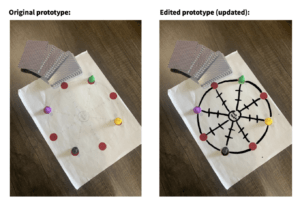
In later iterations, we were forced to consider the question: how do we constrain the rule-making process so that discovering them is a fun process? Our initial iterations did not have any constraints on rule-creation, and especially for playtests with more than 3 people, this made the game extremely chaotic. Because players were naturally competitive, they tried to make their games complicated so people would trip up, but for first time players, they did not understand that having secret rules already makes it inherently difficult even if the rule itself is simple. As such, our initial playtests had a pretty steep learning curve, and game-time stretched to over 30 minutes because players kept getting penalized. To fix this, we decided to provide card templates for players to fill in that also have suggestions of conditions and actions to make rules more learnable. This proved to be a good decision, as our final playtest only lasted <15 minutes.
Many more careful design decisions went into the creation of Order of the Toads, and those will be discussed in more detail in the next section about iterations and playtests. As such, these were the main design decisions that lead to the backbone of our game, but at the end of the day, all of our design decisions were geared towards our goal of having fun within organized chaos, where we let the reins just loose enough for players to experience the aesthetics of expression, fellowship, and challenge without devolving into a stalemate.
Testing and Iterations
Initial Testing
The Testers: 4 team members and 1 friend
Iteration: 2 rounds of gameplay in one same sitting
Key Mechanics:
- Used one deck of cards
- Players text moderator rules
- Moderator also can come up with their own rule
- Played one round with 5 cards as initial hand and another round with 3 cards as initial hand
- Penalty for not performing necessary actions AND for performing unnecessary actions
What we learned and changed:
- Initial hand from 5 cards is too much so we changed it to 3 cards. However, we realized that 3 cards might be too few for anything to happen. We need more testing for this element.
- Added extra penalty to performing unnecessary actions to prevent people from cheating the system by just performing all possible actions at all times.
- Moderator has too much power if he/she can also have their own rule.
Second-stage Testing
The Testers: 4 – 6 new classmates + 1 team member each round
Iteration: 2 rounds of gameplay in different in-class playtesting sessions
Key Mechanics:
- Introduced a board element to allow Players text moderator rules for one game and players write down rules on paper for another.
- Because of the board, we limited the number of players to a maximum of 8.
- Moderator cannot come up with a new rule.
- Played both rounds with 4 cards as the initial hand.
- Penalty for not performing necessary actions AND for performing unnecessary actions.
What we learned and changed:
- The board element gave the game more flexibility and shortened game play while increasing fun since it is not as difficult to find out rules as our previous iteration.
- We realized that we need to organize a way to let the moderator know about the rules. Texting is not an efficient option especially if the players don’t have the moderator’s number.
- 4 cards is a good number for the starting hand. We are keeping this.
- 7 people playing seems a bit too complicated. We are thinking of cutting the player number but we need further testing for this element.
Third-stage Testing
The Testers: 5 classmates (first time no team members are involved!)
Iteration: 1 round of gameplay in in-class playtesting session
Key Mechanics:
- Reduced maximum total players from 8 players to 6 players.
- Reduced steps between each stop on board from 4 to 2.
- Removed penalty for unnecessary actions.
- Modified rules by designing a if (_trigger_) the do (_action_) card for players to fill in.
What we learned and changed:
- From the last playtesting iteration, we realized that having 7 unique rules is too much for the players to figure out and the moderator to keep track of, so we reduced maximum player count to 6 (5 unique rules).
- To make the game more fun and easier, we reduced the count of steps on the board so it is easier for players to advance to others’ towers to get hints and/or the hidden rules.
- Penalty for unnecessary actions is too hard for the moderator to manage so we took that penalty out.
- The players’ rules are too unorganized so we created a way for them to just fill in the template by coming up with a single card-related trigger and an action.
Final Testing
The Testers: 2 CAs + 2 Classmates (still no team members involved)
Iteration: 1 round of gameplay after class
Key Mechanics:
- Play tested with high-fidelity materials. Theme was implemented.
- Materials include: a themed box, instruction booklet, a physical board, physical toad pawn pieces, moderator tracking card (to keep track of rules associated with certain cards), rule creation template cards, and toad-themed playing cards.
- Decreased the maximum number of players from 6 to 5 (4 unique rules).
- Provided instruction cards and let the testers figure out the game on their own. Complete hands-off playtest.
What we learned and changed:
- We realized having actual rule creation cards with examples of triggers and actions significantly helped regulate chaos of the rules.
- The theming was fully implemented which added a new type of fun: fantasy (we asked the testers what type of fun they felt and it included fantasy which was never mentioned in our previous iterations).
- Interesting comments: one play tester even noted that he “truly felt like the Great Toad” which is an artifact of how our theming impacted the dynamic of the game.
. 
Tristan reading the rule book Ale writing down his rule
Setting up the game Middle of gameplay!
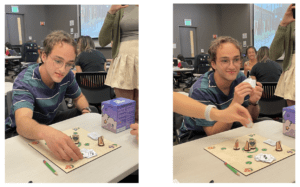
Ale nervous about getting penalized Ale after successfully placing a card!
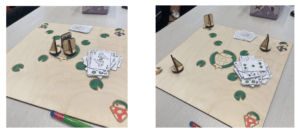 Everyone successfully asked the Great Toad a question Everyone on their way to attack other huts!
Everyone successfully asked the Great Toad a question Everyone on their way to attack other huts!
Click here to watch our final playtest! Shoutout to Ale and Krishnan for helping us playtest 🙂
Printables & Mockups
We have compiled a pdf of all the printable materials needed to play Order of the Toads and put it in this blog post on the class website.
However, this does not include any of the extra designs or artifacts we made for our physical prototype. We also created a physical prototype which included a laser-cut board and player pieces, themed laminated playing cards, a laminated moderator card to increase reusability, paper rule cards, and a few pencils and whiteboard markers.

Physical box for Order of the Toads
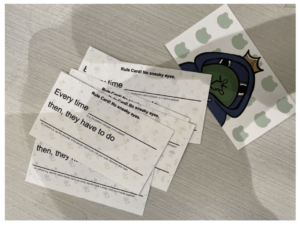
Rule Cards w/ Back

From left to right: Instruction booklet and Moderator Notes
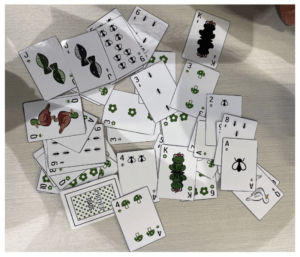
Themed Playing Cards w/ Back
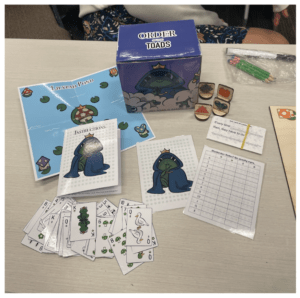
The complete physical prototype for Order of the Toads
Additionally, here are some links to the design mockups we made throughout the process:
- Prototype 1 (Checkpoint 2)
- Prototype 2 (Checkpoint 3)
- Final Prototype:


